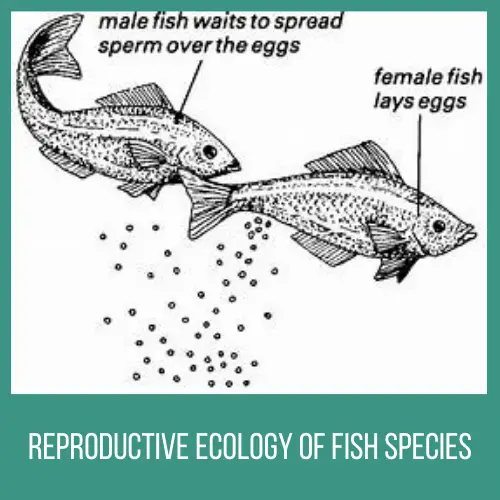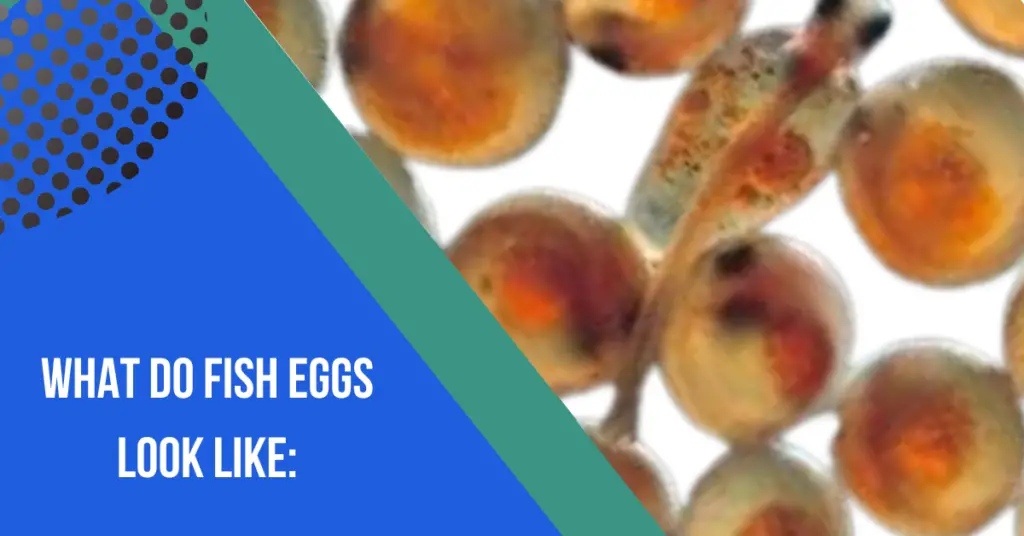Contents
- 1 What do fish eggs look like:
- 2 Importance of identifying fish eggs:
- 3 Appearance of Fish Eggs:
- 4 Size:
- 5 Shape:
- 6 Color:
- 7 FAQs:
- 8 Q: What do fish eggs look like?
- 9 Q: Why is it important to identify fish eggs?
- 10 Q: How can I identify fish eggs?
- 11 Q: What factors influence the appearance of fish eggs?
- 12 Q: What role do fish eggs play in aquatic ecosystems?
Fish eggs, also known as roe, come in various shapes, sizes, and colors depending on the species. Generally, fish eggs are small, spherical or oval-shaped structures ranging from a few millimeters to several centimeters in diameter.
They can appear translucent or opaque and may vary in color from pale yellows and oranges to darker hues such as reds or browns.
Additionally, fish eggs often have a slightly gelatinous texture and are typically found within clusters or strands, adhering to aquatic vegetation or submerged surfaces in freshwater or marine environments.
What do fish eggs look like:
Fish eggs, also known as roe, can vary significantly in appearance depending on the species.

However, some general characteristics can help identify them:
- Size: Fish eggs range in size from tiny, barely visible specks to larger spheres. They can be as small as 1 millimeter or less and can grow up to several millimeters or even centimeters in diameter.
- Color: The color of fish eggs varies greatly among species. They can be translucent, opaque, or even brightly colored. Common colors include pale yellows, oranges, reds, and browns.
- Shape: Fish eggs are typically spherical or oval-shaped, but they can also be slightly elongated or irregular in shape.
- Texture: Fish eggs often have a slightly gelatinous texture when fresh. However, this can vary depending on factors such as species and water conditions.
- Clustered Appearance: Fish eggs are usually found in clusters or strands, adhering to surfaces such as aquatic vegetation, rocks, or other submerged objects.
- Habitat and Attachment: Fish eggs are commonly found in freshwater or marine environments, depending on the species. They are often attached to surfaces within these habitats, providing protection and stability for the developing embryos.
Overall, fish eggs exhibit a diverse range of appearances, reflecting the vast diversity of fish species found in aquatic ecosystems.
Importance of identifying fish eggs:
Identifying fish eggs is crucial for several reasons:
- Species Identification: Different fish species have distinct egg characteristics. Identifying fish eggs allows scientists and researchers to determine which species are present in a particular habitat, providing valuable information for ecological studies, conservation efforts, and fisheries management.
- Population Monitoring: Monitoring fish egg abundance and distribution can help assess the health and status of fish populations. Changes in the abundance or distribution of fish eggs over time may indicate shifts in population dynamics, habitat quality, or environmental conditions.
- Reproductive Ecology: Understanding the reproductive ecology of fish species, including their spawning behavior, timing, and habitat preferences, relies on the ability to identify their eggs. This knowledge is essential for predicting spawning events, protecting critical spawning habitats, and managing fisheries sustainably.
- Environmental Monitoring: Fish eggs are sensitive to changes in water quality, temperature, and other environmental factors. Monitoring changes in fish egg abundance, condition, or distribution can serve as an early warning system for detecting environmental disturbances, such as pollution, habitat degradation, or climate change impacts.
- Fisheries Management: Fish eggs represent the next generation of fish populations. Assessing the abundance and condition of fish eggs can inform fisheries management decisions, such as setting catch limits, establishing protected areas, or implementing habitat restoration projects to support fish reproduction and recruitment.
- Conservation: Some fish species are threatened or endangered, and their eggs may be particularly vulnerable to disturbances or habitat degradation. Identifying and protecting critical spawning habitats and minimizing threats to fish eggs are essential for conserving vulnerable fish populations and maintaining biodiversity.

In summary, identifying fish eggs is essential for understanding fish population dynamics, reproductive ecology, environmental health, and fisheries management, ultimately contributing to the conservation and sustainable use of aquatic resources.
Appearance of Fish Eggs:
The appearance of fish eggs can vary significantly depending on the species, but here are some general characteristics:
- Size: Fish eggs range in size from specks to larger spheres, with diameters typically ranging from less than 1 millimeter to several millimeters or even centimeters.
- Color: Fish eggs come in a variety of colors, including translucent, opaque, and brightly colored hues such as yellow, orange, red, brown, or even greenish tones.
- Shape: Most fish eggs are spherical or oval-shaped, although some may be slightly elongated or irregular in shape.
- Texture: Fresh fish eggs often have a slightly gelatinous texture, providing protection and buoyancy for the developing embryos. However, this texture may change over time or depending on environmental conditions.
- Clustered Appearance: Fish eggs are usually found in clusters or strands, adhering to surfaces such as aquatic vegetation, rocks, or other submerged objects. This clustered appearance helps protect the eggs and provides stability in the aquatic environment.
Overall, the appearance of fish eggs reflects the diversity of fish species and their adaptations to different aquatic environments. Identifying fish eggs based on their size, color, shape, texture, and clustered appearance is important for understanding fish reproductive ecology, population dynamics, and ecosystem health.
Size:
Fish eggs vary greatly in size depending on the species. Here’s an overview:

- Microscopic: Some fish eggs are so small that they are barely visible to the naked eye. These eggs can be less than 1 millimeter in diameter and may require a microscope for detailed observation.
- Small to Medium-Sized: Many fish species produce eggs that are small to medium-sized, typically ranging from a few millimeters to several millimeters in diameter. These eggs are visible to the naked eye but are still relatively small compared to other objects in the aquatic environment.
- Large: Certain fish species, particularly those with larger body sizes, may produce relatively large eggs. These eggs can range from several millimeters to centimeters in diameter and are more easily noticeable in the water.
Overall, the size of fish eggs can vary significantly, even within the same aquatic ecosystem, depending on factors such as species, reproductive strategy, and environmental conditions.
Understanding the size range of fish eggs is important for identifying and studying different fish species, as well as assessing their reproductive biology and ecological roles within aquatic ecosystems.
Shape:
The shape of fish eggs can vary among species, but they generally fall into one of several categories:

- Spherical: Many fish eggs are spherical, resembling tiny balls. This rounded shape helps them roll and remain buoyant in the water, aiding in their distribution and survival.
- Oval: Some fish eggs have an oval shape, resembling elongated spheres. These eggs may be slightly flattened or elongated along one axis, but they still maintain a generally rounded appearance.
- Irregular: In addition to spherical and oval shapes, fish eggs can also exhibit irregular or asymmetrical shapes. Factors such as genetic variation, environmental conditions, and developmental stage can contribute to variations in egg shape.
- Adaptations: The shape of fish eggs may be influenced by adaptations to their specific reproductive strategies and environmental conditions. For example, eggs of species that spawn in flowing water may have streamlined shapes to reduce drag, while eggs of species that attach to the substrate may have specialized structures for anchoring.
Overall, the shape of fish eggs reflects the diverse range of adaptations and reproductive strategies found in different fish species.
Understanding egg shape is important for species identification, studying reproductive biology, and assessing ecological roles within aquatic ecosystems.
Color:
Fish eggs come in a variety of colors, which can provide clues about the species, habitat, and developmental stage. Here are some common colors observed in fish eggs:

- Translucent: Many fish eggs appear translucent or semi-transparent, allowing some light to pass through. This transparency can make the eggs difficult to see, especially in certain lighting conditions or water environments.
- Opaque: Some fish eggs have an opaque appearance, meaning they are not transparent and do not allow light to pass through. Opaque eggs may appear whitish, cream-colored, or pale depending on the species and environmental factors.
- Yellow and Orange: Many fish eggs exhibit shades of yellow or orange, ranging from pale pastel tones to vibrant hues. These colors are often associated with carotenoid pigments found in the egg yolk, which provide essential nutrients for developing embryos.
- Red and Brown: Some fish eggs have reddish or brownish colors, which may result from the presence of other pigments such as melanin or hemoglobin. These colors can vary in intensity and may be influenced by factors such as water quality, substrate type, and environmental conditions.
- Green and Blue: In certain species, fish eggs may appear greenish or bluish due to the presence of specific pigments or reflectance properties. These colors are less common but can be observed in some marine and freshwater fish eggs.
- Variability: The color of fish eggs can vary within and among species, populations, and individual eggs. Environmental factors, genetic variation, and developmental stage can all contribute to variability in egg color.
Overall, the color of fish eggs is influenced by a combination of genetic, physiological, and environmental factors.
Understanding egg color can provide valuable information about fish species, reproductive biology, and ecological interactions within aquatic ecosystems.
Conclusion:
fish eggs exhibit a diverse range of characteristics including size, shape, and color, which are influenced by factors such as species, reproductive strategy, and environmental conditions.
Identifying fish eggs is essential for understanding fish reproductive ecology, population dynamics, and ecosystem health. Fish eggs play a vital role in aquatic ecosystems as they represent the next generation of fish populations.
Monitoring fish egg abundance, distribution, and condition provides valuable insights into the health and status of fish populations, guiding conservation efforts and fisheries management strategies.
Overall, understanding the appearance of fish eggs contributes to our knowledge of aquatic biodiversity and helps ensure the sustainable use and conservation of aquatic resources for future generations.
FAQs:
Q: What do fish eggs look like?
A: Fish eggs, also known as roe, come in various shapes, sizes, and colors depending on the species. Generally, they are small, spherical or oval-shaped structures ranging from a few millimeters to several centimeters in diameter.
They can appear translucent or opaque and may vary in color from pale yellows and oranges to darker hues such as reds or browns. Fish eggs often have a slightly gelatinous texture and are typically found within clusters or strands, adhering to aquatic vegetation or submerged surfaces.
Q: Why is it important to identify fish eggs?
A: Identifying fish eggs is crucial for several reasons. It helps with species identification, population monitoring, understanding reproductive ecology, environmental monitoring, fisheries management, and conservation efforts.
Fish eggs provide valuable information about fish populations, reproductive behavior, and ecosystem health, guiding management and conservation strategies for the sustainable use of aquatic resources.
Q: How can I identify fish eggs?
A: Fish eggs can be identified based on their size, shape, color, texture, and clustered appearance. They vary greatly among species, so it’s essential to consider multiple characteristics for accurate identification.
Using field guides, consulting experts, or employing microscopy techniques can aid in the identification process.
Q: What factors influence the appearance of fish eggs?
A: The appearance of fish eggs is influenced by factors such as species, reproductive strategy, genetic variation, environmental conditions, and developmental stage.
Different species have distinct egg characteristics, and environmental factors such as water quality, temperature, and substrate type can also affect egg appearance.
Q: What role do fish eggs play in aquatic ecosystems?
A: Fish eggs are essential for maintaining aquatic biodiversity and ecosystem functioning. They represent the next generation of fish populations and contribute to the food web as prey for various organisms.
Fish eggs also serve as indicators of environmental health and play a crucial role in nutrient cycling and energy transfer within aquatic ecosystems. Protecting fish eggs and their habitats is vital for the conservation and sustainability of aquatic resources.








